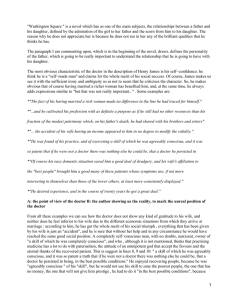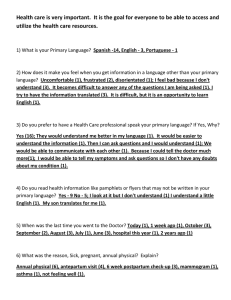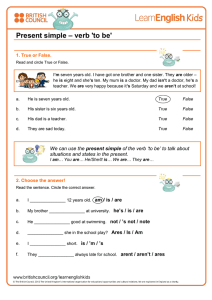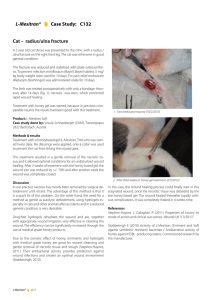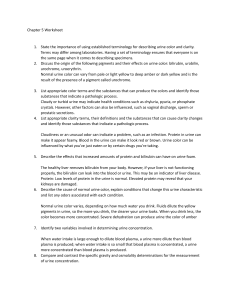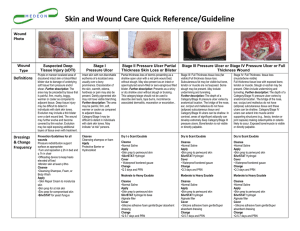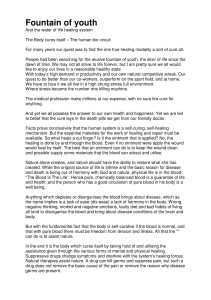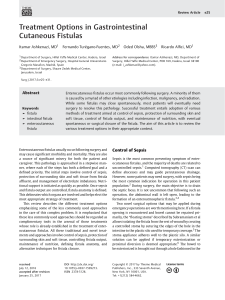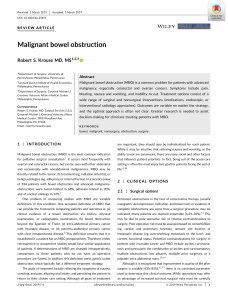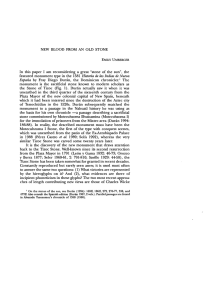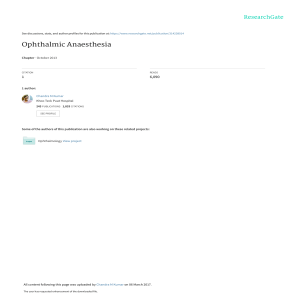Ureterolithotomy (Open) PROCEDURAL CONSENT FORM
Anuncio
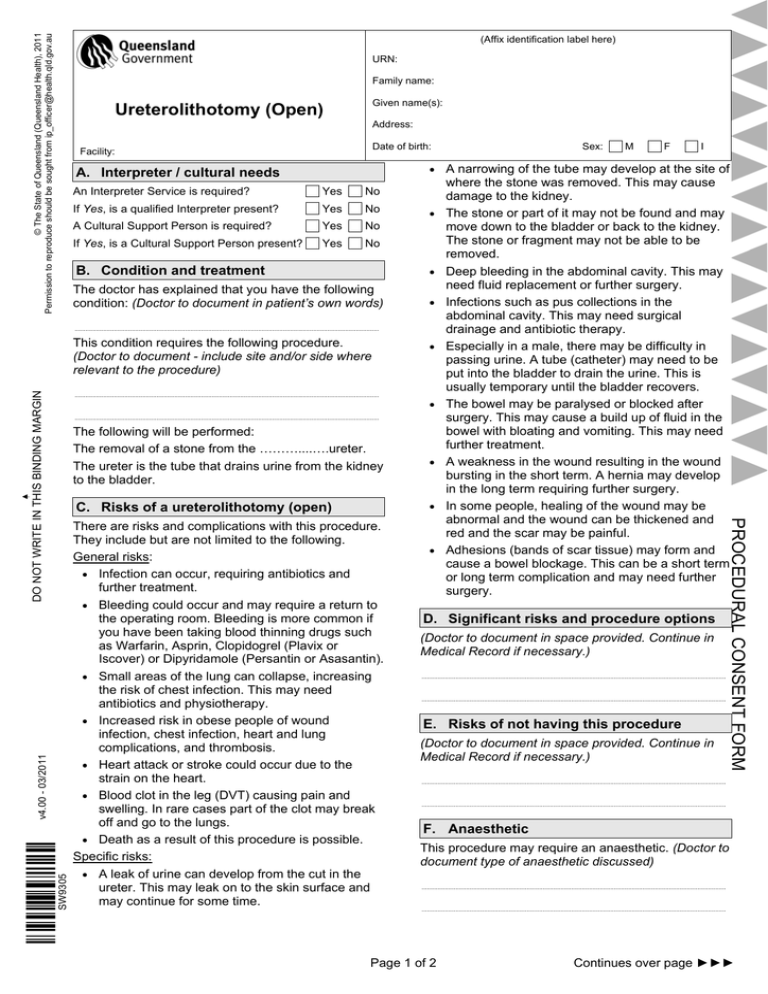
© The State of Queensland (Queensland Health), 2011 Permission to reproduce should be sought from ip_officer@health.qld.gov.au (Affix identification label here) URN: Family name: Given name(s): Ureterolithotomy (Open) Address: Date of birth: Facility: An Interpreter Service is required? Yes No If Yes, is a qualified Interpreter present? Yes No A Cultural Support Person is required? Yes No If Yes, is a Cultural Support Person present? Yes No B. Condition and treatment The doctor has explained that you have the following condition: (Doctor to document in patient’s own words) ........................................................................................................................................................................... This condition requires the following procedure. (Doctor to document - include site and/or side where relevant to the procedure) ........................................................................................................................................................................... ........................................................................................................................................................................... The following will be performed: The removal of a stone from the ………....….ureter. The ureter is the tube that drains urine from the kidney to the bladder. C. Risks of a ureterolithotomy (open) SW9305 F I There are risks and complications with this procedure. They include but are not limited to the following. General risks: Infection can occur, requiring antibiotics and further treatment. Bleeding could occur and may require a return to the operating room. Bleeding is more common if you have been taking blood thinning drugs such as Warfarin, Asprin, Clopidogrel (Plavix or Iscover) or Dipyridamole (Persantin or Asasantin). Small areas of the lung can collapse, increasing the risk of chest infection. This may need antibiotics and physiotherapy. Increased risk in obese people of wound infection, chest infection, heart and lung complications, and thrombosis. Heart attack or stroke could occur due to the strain on the heart. Blood clot in the leg (DVT) causing pain and swelling. In rare cases part of the clot may break off and go to the lungs. Death as a result of this procedure is possible. Specific risks: A leak of urine can develop from the cut in the ureter. This may leak on to the skin surface and may continue for some time. where the stone was removed. This may cause damage to the kidney. The stone or part of it may not be found and may move down to the bladder or back to the kidney. The stone or fragment may not be able to be removed. Deep bleeding in the abdominal cavity. This may need fluid replacement or further surgery. Infections such as pus collections in the abdominal cavity. This may need surgical drainage and antibiotic therapy. Especially in a male, there may be difficulty in passing urine. A tube (catheter) may need to be put into the bladder to drain the urine. This is usually temporary until the bladder recovers. The bowel may be paralysed or blocked after surgery. This may cause a build up of fluid in the bowel with bloating and vomiting. This may need further treatment. A weakness in the wound resulting in the wound bursting in the short term. A hernia may develop in the long term requiring further surgery. In some people, healing of the wound may be abnormal and the wound can be thickened and red and the scar may be painful. Adhesions (bands of scar tissue) may form and cause a bowel blockage. This can be a short term or long term complication and may need further surgery. D. Significant risks and procedure options (Doctor to document in space provided. Continue in Medical Record if necessary.) ........................................................................................................................................................................... ........................................................................................................................................................................... E. Risks of not having this procedure (Doctor to document in space provided. Continue in Medical Record if necessary.) PROCEDURAL CONSENT FORM DO NOT WRITE IN THIS BINDING MARGIN M A narrowing of the tube may develop at the site of A. Interpreter / cultural needs v4.00 - 03/2011 Sex: ........................................................................................................................................................................... ........................................................................................................................................................................... F. Anaesthetic This procedure may require an anaesthetic. (Doctor to document type of anaesthetic discussed) ........................................................................................................................................................................... ........................................................................................................................................................................... Page 1 of 2 Continues over page ►►► (Affix identification label here) URN: Family name: Ureterolithotomy (Open) Given name(s): Address: Date of birth: Sex: M F I G. Patient consent I request to have the procedure I acknowledge that the doctor has explained; my medical condition and the proposed procedure, including additional treatment if the doctor finds something unexpected. I understand the risks, including the risks that are specific to me. the anaesthetic required for this procedure. I understand the risks, including the risks that are specific to me. other relevant procedure/treatment options and their associated risks. my prognosis and the risks of not having the procedure. that no guarantee has been made that the procedure will improve my condition even though it has been carried out with due professional care. the procedure may include a blood transfusion. tissues and blood may be removed and could be used for diagnosis or management of my condition, stored and disposed of sensitively by the hospital. if immediate life-threatening events happen during the procedure, they will be treated based on my discussions with the doctor or my Acute Resuscitation Plan. a doctor other than the Consultant may conduct the procedure. I understand this could be a doctor undergoing further training. I have been given the following Patient Information Sheet/s: Name of Patient: .......................................................................................................................... Ureterolithotomy (Open) I was able to ask questions and raise concerns with the doctor about my condition, the proposed procedure and its risks, and my treatment options. My questions and concerns have been discussed and answered to my satisfaction. I understand I have the right to change my mind at any time, including after I have signed this form but, preferably following a discussion with my doctor. I understand that image/s or video footage may be recorded as part of and during my procedure and that these image/s or video/s will assist the doctor to provide appropriate treatment. On the basis of the above statements, Date: ...................................................................................................................................................... Patients who lack capacity to provide consent Consent must be obtained from a substitute decision maker/s in the order below. Does the patient have an Advance Health Directive (AHD)? Yes Location of the original or certified copy of the AHD: ................................................................................................................................................................ No Name of Substitute Decision Maker/s: ............................................................................................................... DO NOT WRITE IN THIS BINDING MARGIN About Your Anaesthetic Signature: .......................................................................................................................................... Signature: ..................................................................................................................................... Relationship to patient: ................................................................................................. Date: ....................................................... PH No: .................................................................. Source of decision making authority (tick one): Tribunal-appointed Guardian Attorney/s for health matters under Enduring Power of Attorney or AHD Statutory Health Attorney If none of these, the Adult Guardian has provided consent. Ph 1300 QLD OAG (753 624) H. Doctor/delegate Statement I have explained to the patient all the above points under the Patient Consent section (G) and I am of the opinion that the patient/substitute decisionmaker has understood the information. Name of Doctor/delegate: ....................................................................................................................... Designation:.................................................................................................................................. Signature: ........................................................................................................................................ Date: ...................................................................................................................................................... I. Interpreter’s statement I have given a sight translation in ..................................................................................................................................................................... (state the patient’s language here) of the consent form and assisted in the provision of any verbal and written information given to the patient/parent or guardian/substitute decision-maker by the doctor. Name of Interpreter: ...................................................................................................................................... Signature: ........................................................................................................................................ Date: ...................................................................................................................................................... Page 2 of 2 03/2011 - v4.00 Facility: © The State of Queensland (Queensland Health), 2011 Permission to reproduce should be sought from ip_officer@health.qld.gov.au Consent Information - Patient Copy Ureterolithotomy (Open) Infections such as pus collections in the 1. What do I need to know about this procedure? A Ureterolithotomy is an open surgical procedure that will remove a stone from the ureter. The ureter is the tube that drains urine from the kidney to the bladder. 2. My anaesthetic This procedure will require an anaesthetic. See About Your Anaesthetic information sheet for information about the anaesthetic and the risks involved. If you have any concerns, discuss these with your doctor. If you have not been given an information sheet, please ask for one. 3. What are the risks of this specific procedure? 03/2011 - v4.00 There are risks and complications with this procedure. They include but are not limited to the following. General risks: Infection can occur, requiring antibiotics and further treatment. Bleeding could occur and may require a return to the operating room. Bleeding is more common if you have been taking blood thinning drugs such as Warfarin, Asprin, Clopidogrel (Plavix or Iscover) or Dipyridamole (Persantin or Asasantin). Small areas of the lung can collapse, increasing the risk of chest infection. This may need antibiotics and physiotherapy. Increased risk in obese people of wound infection, chest infection, heart and lung complications, and thrombosis. Heart attack or stroke could occur due to the strain on the heart. Blood clot in the leg (DVT) causing pain and swelling. In rare cases part of the clot may break off and go to the lungs. Death as a result of this procedure is possible. Specific risks: A leak of urine can develop from the cut in the ureter. This may leak on to the skin surface and may continue for some time. A narrowing of the tube may develop at the site of where the stone was removed. This may cause damage to the kidney. The stone or part of it may not be found and may move down to the bladder or back to the kidney. The stone or fragment may not be able to be removed. Deep bleeding in the abdominal cavity. This may need fluid replacement or further surgery. abdominal cavity. This may need surgical drainage and antibiotic therapy. Especially in a male, there may be difficulty in passing urine. A tube (catheter) may need to be put into the bladder to drain the urine. This is usually temporary until the bladder recovers. The bowel may be paralysed or blocked after surgery. This may cause a build up of fluid in the bowel with bloating and vomiting. This may need further treatment. A weakness in the wound resulting in the wound bursting in the short term. A hernia may develop in the long term requiring further surgery. In some people, healing of the wound may be abnormal and the wound can be thickened and red and the scar may be painful. Adhesions (bands of scar tissue) may form and cause a bowel blockage. This can be a short term or long term complication and may need further surgery. Notes to talk to my doctor about: ........................................................................................................................................................................... ........................................................................................................................................................................... ........................................................................................................................................................................... ........................................................................................................................................................................... ........................................................................................................................................................................... ........................................................................................................................................................................... ........................................................................................................................................................................... ........................................................................................................................................................................... ........................................................................................................................................................................... ........................................................................................................................................................................... ........................................................................................................................................................................... ........................................................................................................................................................................... ........................................................................................................................................................................... ........................................................................................................................................................................... ........................................................................................................................................................................... ........................................................................................................................................................................... ........................................................................................................................................................................... ........................................................................................................................................................................... ........................................................................................................................................................................... ........................................................................................................................................................................... ........................................................................................................................................................................... ........................................................................................................................................................................... Page 1 of 1
